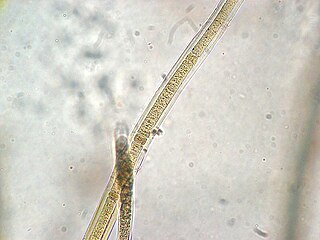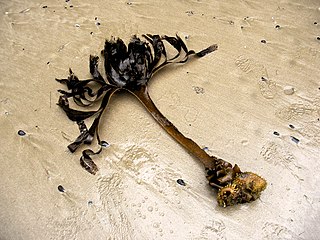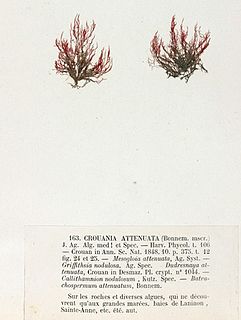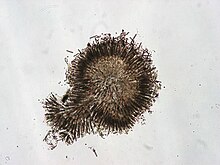
Nostoc is a genus of cyanobacteria found in various environments that forms colonies composed of filaments of moniliform cells in a gelatinous sheath.

Chordariaceae is a family of brown algae. Members of this family are may be filamentous, crustose with fused cells at the base, or they may be terete and differentiated into a central medulla and an outer photosynthetic cortex. They have a sporphytic thallus usually aggregated to form a pseudo-parenchyma.

Turbinaria is a genus of brown algae (Phaeophyceae) found primarily in tropical marine waters. It generally grows on rocky substrates. In tropical Turbinaria species that are often preferentially consumed by herbivorous fishes and echinoids, there is a relatively low level of phenolics and tannins.

Rhodomelaceae is estimated to be the largest red algae family, with about 125 genera and over 700 species.

Scytonema is a genus of photosynthetic cyanobacteria that contains over 100 species. It grows in filaments that form dark mats. Many species are aquatic and are either free-floating or grow attached to a submerged substrate, while others species grow on terrestrial rocks, wood, soil, or plants. Scytonema is a nitrogen fixer, and can provide fixed nitrogen to the leaves of plants on which it is growing. Some species of Scytonema form a symbiotic relationship with fungi to produce a lichen.

Acrochaetiales is an order of red algae.
Cystoseira crassipes is a species of seaweed native to northeast Asia.

Plocamium is a genus of red algae in the family Plocamiaceae. It contains around 40 species and has a cosmopolitan distribution in temperate seas. Plocamium has erect elliptical thalli that grow up to 50 cm (20 in) in length. They are bright red in color with strongly flattened delicately branching fronds that further divide into two to five smaller branchlets.
Wollea is a genus of filamentous, heterocystous cyanobacteria that form macroscopic colonies in freshwater habitats. The genus produces akinetes and is known to reproduce with hormogonia.

The Scytonemataceae are a family of filamentous, heterocystous cyanobacteria within the order Nostocales. The family is known from freshwater, marine, and terrestrial environments, where it grows in colonies attached to the substrate. Akinetes are not known, and the members of the family are known to reproduce with nonheterocystous hormogonia.

Rivularia is a genus of cyanobacteria of the family Rivulariaceae.

Bangiaceae is a family of red algae in the order Bangiales. It contains laver, used to make laverbread, and the species used to make nori as well as other edible seaweeds.

Phyllariaceae is a family of brown algae in the order Tilopteridales.

Crouania is a genus of red algae (Rhodophyta) in the Callithamniaceae family. The name of the genus honours the Crouan brothers, Pierre-Louis Crouan and Hippolyte-Marie Crouan. It was first described by Jacob Georg Agardh in 1842, and the type species is Crouania attenuata.












